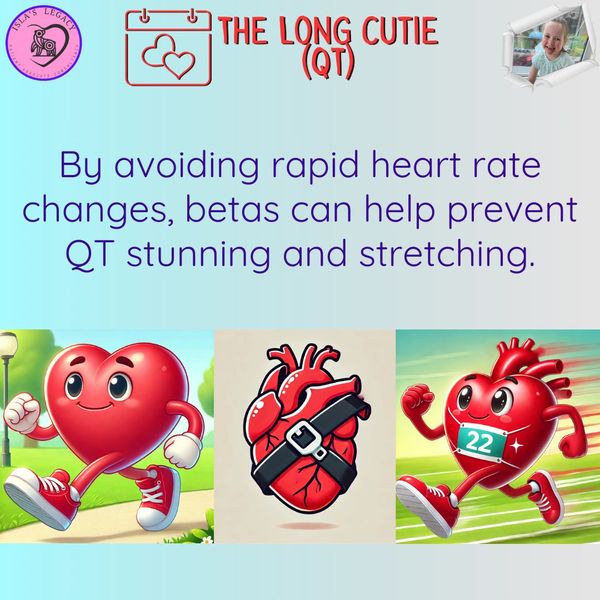Beta Blockers
Here I talk about Stunning and Stretching of the QT due to heart rate changes. Strictly speaking, in literature and scientific studies, stretching is described as happening with an increase in heart rate, and stunning as the heart returns to a resting rate. I’m flipping this on it‘s head because it makes far more sense my way. So bear in mind that elsewhere you might see these the opposite way around.

Beta blockers are preventative medicine for Long QT Syndrome, they are not a cure or a fix for the condition.

They don’t reduce the QT interval but Beta Blockers can prevent the corrected QT interval (QTc) going as long by numbing the adrenaline effect on the heart.

Watch Isaac drumming on the link below for a demo of a normal rhythm and reset and Long QT.
Now think about if a drummer doing:
ba, dum, clashhhhhhhhhh....................
ba, dum, clashhhhhhhhhh....................
suddenly starts playing faster:
ba dum, clashhhhhhhhhh.....
ba, dum, clashhhhhhhhhh....
The clash of the cymbal hasn't got shorter. This is QT stunning.

Now the drummer slows back down:
ba, dum, clashhhhhhhhhh..........
ba, dum, clashhhhhhhhhhhhhhhhhhhhhhh................
ba, dum, clashhhhhhhhhhhhhhhhhhhhhhh...............
The clash of the cymbal echoes longer now.

Normally the QT interval shortens to keep up (quick cymbal clash) with the rhythm tempo.
In Long QT it fails to shorten.
When the tempo slows down, the QT should gradually lengthen (longer clash echo) to match the rhythm again but it overshoots and becomes even longer than expected.
Watch the videos at the bottom for a great demonstration of stunning and stretching of the QT interval caused by a change in heart rate.

By doing this, beta blockers do in a way reduce the QTc, but that is because they keep the heart rate and QT interval under control rather than actually reduce the QT.
Stunning and Stretching
A normal QT
The sequence a heart beats in. P wave - snare drum (red). QRS - kick drum (blue). T wave - cymbal.
To demonstrate how the heart reacts, the cymbal lasts for 1.5 seconds in this video, which is important when we come to the ‘Stunning’ video.
QT stunning
Here we have an example of QT stunning. Exactly like the ‘normal’ video, but this time the tempo is faster. What should happen is that the QT shortens, the T wave is quicker so that the heart is reset and able to rest before the next beat. But if someone has Long QT triggered by a sudden increase in heart rate (LQTS1 and 2) then the QT doesn’t adjust like it should (it doesn’t move, it’s stunned). Here, the cymbal (T wave) still lasts 1.5 seconds. Ideally it should shorten to 1 second. The fact it doesn’t means there’s not much gap between the end of the cymbal and the next beat.
QT Stretching
The QT was stunned when the heart rate suddenly increased. It didn’t change or shorten to adjust to the new heart rate. Now as the heart rate slows back down, the QT knows it should gradually get longer again (because it should have gone shorter but didn’t). Now the heart rate is normal resting rate but the QT is even longer (it has stretched)
See why my way round of stunning and stretching makes more sense!?
This isn’t compensation—it’s residual dysfunction. The ion channels are still recovering from the stress and behaving erratically. After being stressed by a fast rhythm, they don’t just return to normal—they linger in a dysfunctional state, leading to exaggerated QT prolongation. That’s what makes the post-exertion phase so risky in Long QT.
